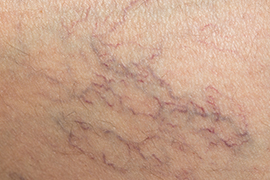Spider Vein Removal

Spider veins are very small varicose veins and telangiectasias. They are thin, threadlike veins that lie close to the skin’s surface and are commonly red or purple in appearance. These dilated vessels may be short, unconnected lines, or connected in a matted “sunburst” pattern. They may also appear web-like or like branches from a tree.
Spider veins are most frequently found on the legs and face, but could be found anywhere on the body. Generally they are not considered a health hazard, but patients may experience a burning, stinging or dull aching pain after prolonged standing.
Some of the most common causes of spider veins include: a genetic predisposition, pregnancy, hormonal changes, oral contraception, trauma, weight gain, and prolonged standing.
What Is Spider Vein Removal?
Spider vein removal is often taken care of by way of laser procedure or sclerotherapy by a trained professional. By using either one of these methods the goal is the same, which is for the body to slowly remove the collapsed veins during the natural healing process, and in return reduce the appearance of the spider veins.
Sclerotherapy
Sclerotherapy or injection of varicose veins is a procedure designed to improve the appearance of your varicose veins. The veins are injected with a solution called a sclerosant agent which damages the internal lining of the vein and causes blood clotting within the vein. In time, your own body will then destroy the vein and it will disappear.
Laser Leg Veins
Simple laser treatment is done for small spider veins and tiny varicose veins. This is sometimes a second treatment step, after a larger varicose vein has been treated with surgery, endovenous laser or radiofrequency treatment, or sclerotherapy.
How Many Treatments Do I Need?
Each individual patient is different, depending upon the number and severity of the veins. Generally patients should expect between 1 and 3 treatments, about 6-8 weeks apart. The treatment improves the overall appearance of the blood vessels, shrinking, diminishing or removing them completely. Vein treatments should not be considered a cure. New developing veins cannot be prevented.
What Happens To The Skin After The Treatment?
Soon after the procedure, you may feel a slight bump on the skin, which will disappear in the next 2-4 hours. The area may also appear slightly redder and occasionally may swell or bruise. Infrequently pigment changes occur (darkening of the skin), and will disappear and return to normal over time. After laser therapy, it is strongly recommended to stay out of direct sun exposure for a week or two. Wearing support hose can facilitate results.
When Can I Return To Work After Laser Therapy?
After treatment, there is no down time and very little discomfort. Patients are encouraged to resume all normal activities immediately. Final results may not be apparent for several weeks. Most patients are satisfied by the results in a very short time.
